Saturday, February 18, 2006
Farewell Xian
My cold was getting worse as The Yangtze Rivers of phlegm were flooding my sinuses into The Great Gorges. The dry and dusty air continues to make my skin itch, and those truly awful Chinese cigarettes and even the fake western ones were making me cough like a Canuck Moose. When I read the health warning 'Smiking dimages your hill' on my replica Marlboros, I knew it was time to quit & move on, believing for no sane reason, that I'd feel better in Shanghai. I felt like a shark, which like all fish, must keep moving to breath.
Friday, February 17, 2006
Risky Monkey Business
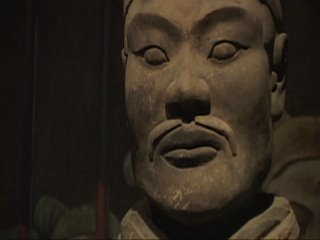 Terracotta Warrior awaits me for over 2000 years. We arrived fairly early, but there was already a queue the length of the Great Wall, snaking around the square like a giant python, and controlled with difficulty by guards armed with those omnipresent electronic megaphones at 10-metre intervals, using them like whips to stop the queue from disintegrating into a heaving mob.
Terracotta Warrior awaits me for over 2000 years. We arrived fairly early, but there was already a queue the length of the Great Wall, snaking around the square like a giant python, and controlled with difficulty by guards armed with those omnipresent electronic megaphones at 10-metre intervals, using them like whips to stop the queue from disintegrating into a heaving mob.As I was about to join the queue, Mister Adidas points out to me that no one is allowed to bring in video cameras. I guess Emperor Qin had a phobia about them in case I was to divulge his secret whereabouts to the peasant rebels or something. On top of the X-ray machine at the head of the queue reads ‘In the spirit of fang bien, your bags must be checked in at the building off the square’. How annoying is that! I wasn’t gonna come all the way out here & leave without a single frame…this monkey’s gonna come up with a scam…think hard monkey…
The warrior site looked like a typical Chinese tourist attraction. The long street leading up to the entrance was filled with souvenir shops and food concessions. You could buy any imaginable junket available from any diaspora Chinatown, as well as Mao kitschs like watches with him happily waving his arm to count off the seconds. Of course, there were 1001 replicas of the stone warriors, from inch-high miniatures to life-size statues.
The entrance fee was 65 RMB, roughly 10 bucks Canadian Tire Money, & this monkey didn’t get busted for sneaking in his video camera. No complicated ‘Mission Impossible’ scams or anything…I simply left my camera bag behind with Mister Adidas who stayed outside the gate while I glided pass security & scoped out the joint, then I went back to the fence about 20 feet away from the main security & waited for the trained monkeys to get distracted by the fresh busload of suckers…ahhh…I meant tour groups checking in. At which point I waved Mister Adidas over & had him toss my camera bag over the fence. Voila!
2000 years ago, the price for that would have been live burial or decapitation for me, if I was lucky, and in the fine Peking Opera tradition, prostitution for William with some powerful warlord. But since The 'Son of Heaven' no longer exists, I was safe from the chopping block & William didn’t have to put out! However I did fear for my life as surging troops of Chinese tour groups in different colour baseball caps waddled around threatening to squash me as they collided.
Each group was led by tour guide leaders waving small rectangular flags, armed with those tiny quacking electronic megaphones, leading their pack around the square, like mother goose leading her flock in a V-formation. Near the centre of the square, things got too crowded for a classic V-formation, and the tour groups took on the air of penguins; huddled into each other for protection against the fierce Mongolian wind, all looking in this Antarctica of Terracotta soldiers for somewhere to lay their eggs before Winter set in and the snow started to fall.
After that onslaught, I struggled my way through the tour groups dodging every hustler who wanted to be my personal tour guide for the price of my “Nan Dan Diva in their bed chambers” & entered the three cavernous Russian-style block buildings that held the warriors. It was quite a letdown to say the least.
Each building overlooked a pit that had lines of the soldiers in it. The soldiers looked identical to the lines of replicas in the storefronts I'd just hustled by... but put in a little more scenic setting of a "genuine" archaeological dig. Not quite the Eighth Wonder of the World, as they were touting it. But the 360-degree, 10 projector films were very impressive, showing Xian in 360-degree view & the history of the site. It gave me some ideas for future site-specific film projects.
First Broadcast Deal
 Looks like we're on the Zheng He Trail & he's watching over us from his Star Raft in the sky!
Looks like we're on the Zheng He Trail & he's watching over us from his Star Raft in the sky!I just got word from my producer Cheuk Kwan, that our diaspora series "Chinese Restaurants" scored it's first broadcast deal from Singapore TV; 2 years 6 runs, PAL English version exclusive in Singapore & non-exclusive Asian satelite with a footprint of 21 countries including Hong Kong, China & Japan.
We're now waiting on an Australian deal...will know soon. Hot diggadee dog! If you haven't yet, Go check out our site: http://www.ChineseRestaurants.tv
Tuesday, February 14, 2006
Pear Garden Or Replica?
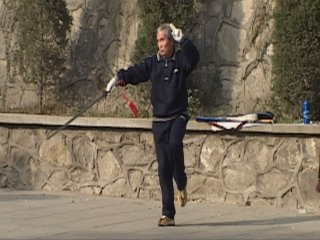 It's Valentine's Day & I didn't even get any fake or replica Valentines today. Plastic flowers are popular items but then product counterfeiting is an epidemic here. So plastic flowers must be someone's idea of fake Valentines.
It's Valentine's Day & I didn't even get any fake or replica Valentines today. Plastic flowers are popular items but then product counterfeiting is an epidemic here. So plastic flowers must be someone's idea of fake Valentines.I've always felt cheated by replicas, but the Chinese don't seem to mind at all. I've noticed this about the Chinese here - they seem to be indifferent towards a replica and the real thing. China is littered with parks where you can see replicas of everything. In the boarder city of Shenzhen, just the other side of my home town, Kowloon, there's a park with replicas of famous structures including the Eiffel Tower, and other famous foreign buildings like the Louvre, Buckingham Palace etc.
Foot massage girl #56 told me the other night, without a trace of irony or sarcasm, that it's more convenient that way, as you can see all the places at once without having to travel around too much, and you only have to pay one entrance fee. As if to prove their point, near the tomb of Emperor Qin, there was even a replica of a pyramid and a sphinx, so you don't have to bother going to Egypt! Is that cool or what! Fang bien strikes again!
Not that I was dieing (no pun intended) to see anything as morbid as Qin’s real tomb. But the nearest you can get to the real tomb is to stand on the hill which it was dug into. From the top of the hill, upon the mausoleum's completion, you could once see all 25 kilometers of the great emperor's magnificent mausoleum complex; an eternal necropolis, walled in and an eternal reminder of his greatness.
I did however wanted to see the site of the original Tang Dynasty Pear Garden, the birthplace of Chinese Opera since I was here to shoot a doc about a Peking Opera journey after all. But no one seemed to know of its exact location or care, including our Peking Opera Aficionado, Master Sun. Just to appease my annoying ‘foreigner’s curiosity’, on route to the Terracotta site along a dusty country road to the northern outskirts of town, Mister Adidas shouted out ‘Camera ! Kwoi ! Camera !’ as he hazardously pointed towards what was just a small dirty factory with some neighboring pig-farming peasants. I wasn’t sure if I was disappointed by the absence of a replica or that this piece of obscure history has totally vanished without a trace. Obscure history has little chance of survival here.
Monday, February 13, 2006
A Treasured Legacy
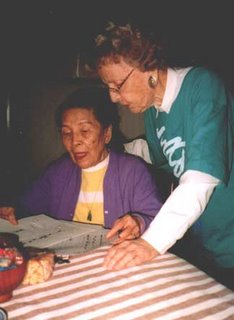 I always get this unexplainable melancholic sadness when I have to say goodbye to my aunties & uncles in China. It always feels like I might not get to see them again…aunties who I’ve only spent short fleeting moments with…but those short fleeting moments become a treasured lifetime.
I always get this unexplainable melancholic sadness when I have to say goodbye to my aunties & uncles in China. It always feels like I might not get to see them again…aunties who I’ve only spent short fleeting moments with…but those short fleeting moments become a treasured lifetime.
We have lost a great patron and friend of the World Arts community. Madame Dai Ai Lian, celebrated dance artist and teacher, pioneer and founder of dance art in modern China, passed away peacefully in her sleep at 17:34 on February 9th, 2006 at the age of 90 in Beijing.
If you are in the vicinities of Beijing this Friday the 17th, there will be a farewell ceremony for Madame Dai at 10 am in the No. 1 Farewell Room of Babaoshan Revolutionary Cemetery.
The rest of us outside of Beijing will remember her in solidarity.
Under Your Qin
 I came to Xian mainly to follow & film William’s Peking Opera journey. But like everyone else, I was compelled to make my way out to see those silly Terra Cotta warrior statues. You know, those life-size replicas built by Emperor Qin to protect him in the afterlife, in place of burying real soldiers alive, standard practice at the time. The soldiers were lucky - his many concubines, servants and all but one of his 22 children did receive the honour of being buried with him, whether they wanted to be or not. Emperor Qin was the first emperor to rule a united China, but also a bit of a paranoid megalomaniac tyrant. It seems that paranoid megalomaniacs always do well, historically speaking. The Bush Dynasty in America is a prime example.
I came to Xian mainly to follow & film William’s Peking Opera journey. But like everyone else, I was compelled to make my way out to see those silly Terra Cotta warrior statues. You know, those life-size replicas built by Emperor Qin to protect him in the afterlife, in place of burying real soldiers alive, standard practice at the time. The soldiers were lucky - his many concubines, servants and all but one of his 22 children did receive the honour of being buried with him, whether they wanted to be or not. Emperor Qin was the first emperor to rule a united China, but also a bit of a paranoid megalomaniac tyrant. It seems that paranoid megalomaniacs always do well, historically speaking. The Bush Dynasty in America is a prime example.After uniting China, Qin set about making sure the whole bloody continent of a country was kept busy glorifying his magnificence, and built the greatest mausoleum the world would ever see. The terra-cotta warriors were only one small part of the 25-kilometer complex that was to ensure his greatness was never forgotten. The workmen involved in building the most sensitive part of the complex, the emperor's tomb, were buried alive in it immediately after it was finished just to ensure no one would know of its secret whereabouts. Talk about a bum rap eh! You spend 25 years - your whole life - slaving away underground on some loony's tomb, and then as soon as you finish, they bury you alive in it. I guess those poor slobs had pretty weak unions. That’s why I gave up my IASTE card…lol.
The irony is that only a year after his death, peasant uprisings destroyed the emperor's vast monument to himself, looting what they could, demolishing what they couldn't and burning the rest. Even the Terra Cotta warriors had their metal weapons stolen and were smashed to pieces. The warriors you see today were apparently put back together again by teams of archaeologists, who are so patient and skilled, they could probably reconstruct Humpty Dumpty plus the wall.
The Chinese can be a very destructive lot when they set their mind to it. They can build on a massive scale, unthinkable by other cultures, but they can also tear it all down again at frightening speed. I know it's a crass generalization, and not my first, but since so little of China's long history is still standing I can't help but make the assertion. Often when it is standing, you’ll find it's just a replica of something that was destroyed earlier, often several times over, and always for no apparent reason. The Cultural Revolution and the vandalism of the Red Guards were just a more recent, and comparatively mild, example of China's periodic lapses into a destructive insanity.
Fortunately, for the emperor, the peasants couldn't find the entrance shaft to his tomb. It was hidden in a mountain, so they never laid their hands on his most valuable loot. There is a replica of the tomb, which modern archaeologists have seen, and it apparently makes Mao’s Mausoleum look like a pauper's grave, but I suppose Mao would be glad to hear that.
Qin’s coffin is in the centre of the enormous circular vault-like tomb, and the coffins of his favourite concubines were buried into walls around him. Those lucky beauties were allowed to swallow poison rather than being buried alive. Bloody favouritism, eh? There are jewels everywhere and more gold than the Aztecs or Egyptians could shake a stick at. There were apparently also rivers of toxic lead and mercury, part of Qin’s deadly booby-traps to protect his loot, which is why tour groups can't see the original, or that's what they told us.
Sunday, February 12, 2006
Goat's Head Soup
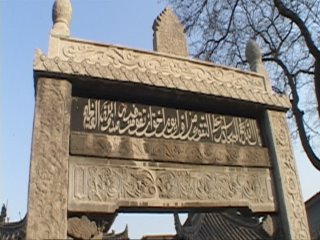 The largest Mosque in all of China, the Great Mosque, is located here. It is Muslim by faith. But with its ornate, eave rooftops, spacious courtyards and stony arches, the architecture is straight Chinese. I’m fascinated by how the Muslims here have co-existed with the Chinese to the point of being absorbed by our culture & yet kept their religion intact & in peace whereas in places like Indonesia, a similar cultural mix have resulted never ending, unresolved race riots. The Great Mosque was probably one of the most authentic untampered sites I’ve visited on this tour. It is pure Tang Dynasty!
The largest Mosque in all of China, the Great Mosque, is located here. It is Muslim by faith. But with its ornate, eave rooftops, spacious courtyards and stony arches, the architecture is straight Chinese. I’m fascinated by how the Muslims here have co-existed with the Chinese to the point of being absorbed by our culture & yet kept their religion intact & in peace whereas in places like Indonesia, a similar cultural mix have resulted never ending, unresolved race riots. The Great Mosque was probably one of the most authentic untampered sites I’ve visited on this tour. It is pure Tang Dynasty! 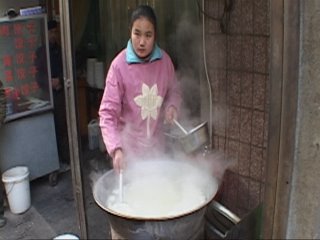 I climbed atop a pile of rubbish, peered down a narrow lane with my camera & caught some handsome Muslim boys in starched white skullcaps stirring bubbling cauldrons with floating goats’ heads. Now I know where Mick Jagger got his idea for his Goat’s Head Soup album. The boys shouted at me in Urdu. It was probably something along the lines of “outta my F-ing face with that camera, dude!”. But I couldn’t make anything out other than their breaths in tiny puffs of steam accented by the harsh back light from an overhead street lantern.
I climbed atop a pile of rubbish, peered down a narrow lane with my camera & caught some handsome Muslim boys in starched white skullcaps stirring bubbling cauldrons with floating goats’ heads. Now I know where Mick Jagger got his idea for his Goat’s Head Soup album. The boys shouted at me in Urdu. It was probably something along the lines of “outta my F-ing face with that camera, dude!”. But I couldn’t make anything out other than their breaths in tiny puffs of steam accented by the harsh back light from an overhead street lantern.  An elderly man waves his fist at a pack of beautifully sullen adolescent girls walking along holding hands. The festive mood rolled back nostalgic childhood memories of late night flower markets during Lunar New Year in Sham Shui Po, my old hood back home in Kowloon.
An elderly man waves his fist at a pack of beautifully sullen adolescent girls walking along holding hands. The festive mood rolled back nostalgic childhood memories of late night flower markets during Lunar New Year in Sham Shui Po, my old hood back home in Kowloon.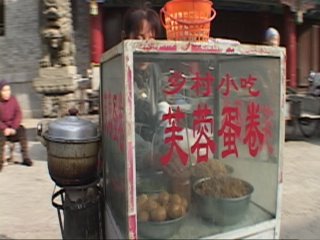 The tall bottles of cheap Chinese beer sold in street stalls became rare since the Muslims bypass on alcohol here. But Xian's redeeming quality for me was the food. We happily ate our way through Culture Street and the Muslim Quarters for cheap, stopping every half a block or so to sample yet another delicious and unknown treat from a street vendor. We tried tons of meat skewers, various deep-fried dumpling things, and endless exotic unknown sweets.
The tall bottles of cheap Chinese beer sold in street stalls became rare since the Muslims bypass on alcohol here. But Xian's redeeming quality for me was the food. We happily ate our way through Culture Street and the Muslim Quarters for cheap, stopping every half a block or so to sample yet another delicious and unknown treat from a street vendor. We tried tons of meat skewers, various deep-fried dumpling things, and endless exotic unknown sweets.
Twilight In Muslim Quarter
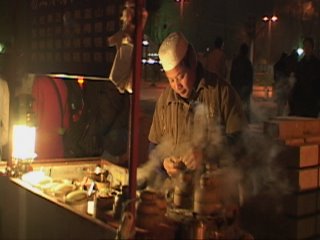 Xian's 70,000 plus Muslims live beyond a dark tunnel just north of Master Sun on the other side of the Ancient City Wall. Like the Peking Opera Costume Hutong in Beijing, The Muslim Quarter is another filthy but beautiful place that sits on the verge of extinction. The bright lights perched on the sparse branches punctuate the darkness like tiny pin pricks of neon. In the late twilight hours when few patrons are around, the undiffused, raw lights elongate the shadows of passers-by. People come here to stroll around & soak up the exotic atmosphere at night. The narrow pathways are unfit to host vehicular traffic; yet annoying automobiles still honk and flash their lights into the dense crowd forcing their way through.
Xian's 70,000 plus Muslims live beyond a dark tunnel just north of Master Sun on the other side of the Ancient City Wall. Like the Peking Opera Costume Hutong in Beijing, The Muslim Quarter is another filthy but beautiful place that sits on the verge of extinction. The bright lights perched on the sparse branches punctuate the darkness like tiny pin pricks of neon. In the late twilight hours when few patrons are around, the undiffused, raw lights elongate the shadows of passers-by. People come here to stroll around & soak up the exotic atmosphere at night. The narrow pathways are unfit to host vehicular traffic; yet annoying automobiles still honk and flash their lights into the dense crowd forcing their way through.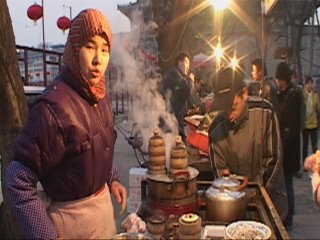 The streets are labyrinthine with symbols of Arabian imperialism appearing sporadically. Women are veiled & swirling Arabic script (God is Great) appears everywhere on storefront marquis. The faces of the people here are rounder, paler, and more Caucasian looking with blue & green eyes. They’re the descendents of Persian merchants who came eastward along the Silk Road & settled down here with babes of the Han Empire. The women are spectacular...jumping right off the pages from Arabian Nights. Boutiques sell appropriate clothing for the believers.
The streets are labyrinthine with symbols of Arabian imperialism appearing sporadically. Women are veiled & swirling Arabic script (God is Great) appears everywhere on storefront marquis. The faces of the people here are rounder, paler, and more Caucasian looking with blue & green eyes. They’re the descendents of Persian merchants who came eastward along the Silk Road & settled down here with babes of the Han Empire. The women are spectacular...jumping right off the pages from Arabian Nights. Boutiques sell appropriate clothing for the believers.We being believers & all had custom tailored traditional suites made for approximately $30 Canadian. A price tag unheard of in Beijing, & most likely laughable in Shanghai. I wasn’t sure if it was operatic training frustration or just regular shopping frenzy, but William played Santa Claus & had 6 Cheongsams made. He probably made the tailor’s year! Merry Christmas…ka-ching $$$$ !
Xmas Twilight Zone
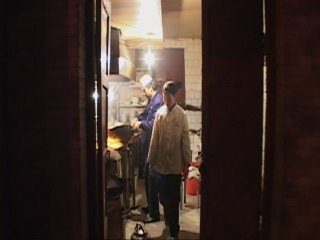 Back in Xian, we get into a somewhat regular routine. Nasty instant coffee & pastry early in the morning before vocal class at 9am to noon. Lunch at our favorite dumpling house. Errands, rest or practices for William till 3pm & we’re back for movement workshop. It’s usually dark by the time we get out & we stroll back leisurely to our hotel along the busy night market. We stumbled upon a really great foot massage place where you get an hour treatment for the price of a Latte at the airport. Since we couldn't find any decent Latte in Xian, that became our favorite pastime for most evenings. It was'nt a bad trade off.
Back in Xian, we get into a somewhat regular routine. Nasty instant coffee & pastry early in the morning before vocal class at 9am to noon. Lunch at our favorite dumpling house. Errands, rest or practices for William till 3pm & we’re back for movement workshop. It’s usually dark by the time we get out & we stroll back leisurely to our hotel along the busy night market. We stumbled upon a really great foot massage place where you get an hour treatment for the price of a Latte at the airport. Since we couldn't find any decent Latte in Xian, that became our favorite pastime for most evenings. It was'nt a bad trade off.We were strolling along the busy night market after class 1 night. The night being Silent Night…well hardly. It was Christmas Eve & giddiish girls wearing cheesy tiaras with blinking LEDs mob the streets. I had already anticipated that spending Christmas in Xian or China would be very different or even strange. Normally, back in Toronto, the streets are empty & silent (thus Silent Night) as everyone huddles at home to be with family. But here, it felt more like a cross between New Years Eve & Mardi-Gras with everyone out wearing festive costumes, many in bright red Santa Claus toots.
This shouldn’t come as a shock to me as shops have been piped with bad Christmas caroling & displaying banners advertising deals ever since we got here. But I do find Christmas strangely way more a commercialize frenzy here in this supposedly Communist State than I care for compare to the Capitalist West as I gazed at the twenty-some feet high plastic Christmas tree in aw.
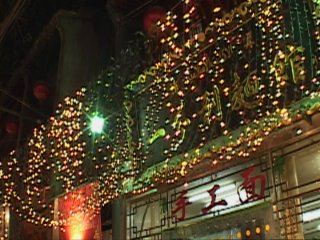 Finally, we found every restaurant fully booked & dinner started to look grim as we got turned away by every Santa Maitre D’ in this Christmas Twilight Zone. In the absence of turkey dinner, we found our way back to our regular evening hangout & celebrated Christmas with our favorite foot masseuses #51 & #56. Well I have to admit; it was the most unlikely place I’d ever imagined ending up on Silent Night. But I’m sure Santa Claus wouldn’t have complained.
Finally, we found every restaurant fully booked & dinner started to look grim as we got turned away by every Santa Maitre D’ in this Christmas Twilight Zone. In the absence of turkey dinner, we found our way back to our regular evening hangout & celebrated Christmas with our favorite foot masseuses #51 & #56. Well I have to admit; it was the most unlikely place I’d ever imagined ending up on Silent Night. But I’m sure Santa Claus wouldn’t have complained.



